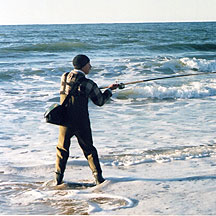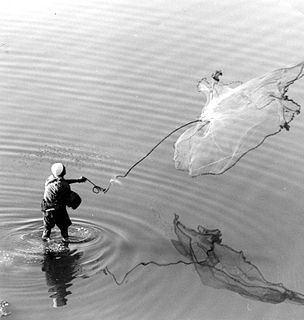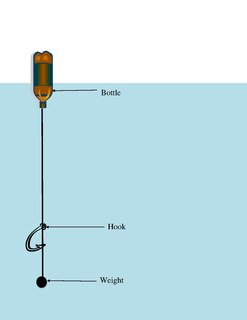
Trolling is a method of fishing where one or more fishing lines, baited with lures or bait fish, are drawn through the water. This may be behind a moving boat, or by slowly winding the line in when fishing from a static position, or even sweeping the line from side-to-side, e.g. when fishing from a jetty. Trolling is used to catch pelagic fish such as salmon, mackerel and kingfish.

A fishing rod is a long, elastic rod used by fishermen to catch fish by manipulating a line ending in a hook. At its simplest form, a fishing rod is a straight stick or pole with a line attached to one end, but modern rods generally have the line stored on a reel mounted at the rod handle, which controls the line retrieval, as well as line-guiding swivels that reduce tangling. To better entice fish, bait or lures are dressed on the one or more hooks attached to the line, and a bite indicator is used, some of which might be incorporated as part of the rod itself.

Angling is a method of fishing by means of a fish hook or "angle". The hook is attached to a fishing line, which is usually manipulated via a fishing rod, although rodless techniques such as handlining also exist. Modern fishing rods are usually fitted with a fishing reel that functions as a cranking device for storing, retrieving and releasing out the line, although Tenkara fishing and cane pole fishing are two rod-angling methods that do not use a reel. The hook itself can be additionally weighted with a tackle called a sinker, and is typically dressed with an appetizing bait to attract the fish, but sometimes an inedible fake bait known as a lure with multiple attached hooks is used in place of a single hook with bait. A bite indicator, such as a float or a quiver tip, is often used to relay underwater status of the hook to the surface.

Spearfishing is a method of fishing that involves impaling the fish with a straight pointed object such as a spear, gig or harpoon. It has been deployed in artisanal fishing throughout the world for millennia. Early civilisations were familiar with the custom of spearing fish from rivers and streams using sharpened sticks.

Bycatch, in the fishing industry, is a fish or other marine species that is caught unintentionally while fishing for specific species or sizes of wildlife. Bycatch is either the wrong species, the wrong sex, or is undersized or juveniles of the target species. The term "bycatch" is also sometimes used for untargeted catch in other forms of animal harvesting or collecting. Non-marine species that are caught but regarded as generally "undesirable" are referred to as "rough fish" and "coarse fish".

Mist nets are used by hunters and poachers, but also by ornithologists and bat biologists to capture wild birds and bats for banding or other research projects. Mist nets are typically made of nylon or polyester mesh suspended between two poles, resembling a volleyball net. When properly deployed in the correct habitat, the nets are virtually invisible. Mist nets have shelves created by horizontally strung lines that create a loose, baggy pocket. When a bird or bat hits the net, it falls into this pocket, where it becomes tangled.

Fishing tackle is the equipment used by anglers when fishing. Almost any equipment or gear used for fishing can be called fishing tackle. Some examples are hooks, lines, sinkers, floats, rods, reels, baits, lures, spears, nets, gaffs, traps, waders and tackle boxes.

In the British Isles, coarse fishing refers to angling for rough fish, which are fish species traditionally considered undesirable as a food or game fish. Freshwater game fish are all salmonids — most particularly salmon, trout and char — so generally coarse fish are freshwater fish that are not salmonids. There is disagreement over whether grayling should be classified as a game fish or a coarse fish.
Groundbait is a fishing bait that is either thrown or "balled" into the water in order to olfactorily attract more fish to a designated area for more efficient catching via angling, netting, trapping, or even spearing and shooting. Groundbaits are typically scattered separately from the hook and usually before even casting any rod or net, although in bottom fishing they can be deployed synchronously with hookbaits while contained inside a gradual-release device also attached to the fishing line known as a feeder.

A fishing float or bobber is an item of angling equipment. Usually attached to a fishing line, it can serve several purposes. Firstly, it can suspend the bait at a predetermined depth; secondly, due to its buoyancy, it can carry the baited hook to otherwise inaccessible areas of water by allowing the float to drift in the prevailing current; and thirdly, a float also serves as a visual bite indicator. Fishing with a float is sometimes called float fishing.

Surf fishing is land-based game fishing while standing on the shoreline or wading into the surf zone. A general term, surf fishing may or may not include casting a lure or bait, and refers to all types of shore fishing – from sandy and rocky beaches, rock jetties, or even fishing piers. The terms surfcasting or beachcasting refer more specifically to surf fishing from the beach by casting into the surf at or near the shoreline. With few exceptions, surf fishing is done in saltwater. The most common misconception about surf fishing is the idea that one must cast as far out as possible in order to reach the fish. At beaches on the west coast of the United States, and in fact, at most beaches around the world, you only really need to get your bait into knee-deep water. This is referred to as surf fishing the "skinny".

Fishing techniques are methods for catching fish. The term may also be applied to methods for catching other aquatic animals such as molluscs and edible marine invertebrates.

The summer flounder is a marine flatfish that is found in the Atlantic Ocean off the East Coast of the United States and Canada. It is especially abundant in waters from North Carolina to Massachusetts.
The following outline is provided as an overview of and topical guide to fishing:

A casting net, also called a throw net, is a net used for fishing. It is a circular net with small weights distributed around its edge.

Mahi-mahi are swift and acrobatic game fish with striking colours. These colours darken when the fish dies The current IGFA all tackle record is 39.91 kilograms (88lb), caught in 1998 in Exuma, Bahamas by Chris Johnson of Lake Mary, Florida. Catches average 7 to 13 kilograms, and any mahi-mahi over 18 kilograms (40 lb) is exceptional. Males are often larger than females.

A bait ball, or baitball, occurs when small fish swarm in a tightly packed spherical formation about a common centre. It is a last-ditch defensive measure adopted by small schooling fish when they are threatened by predators. Small schooling fish are eaten by many types of predators, and for this reason they are called bait fish or forage fish.

Jug fishing is an unlimited class tackle method of fishing that uses lines suspended from floating jugs to catch fish in lakes or rivers. Often, many jugs are used when jug fishing. In many states, a fisherman could use up to twenty, and jug sets of around twenty are common in practice. Jug fishing is most common in southern states where many different kinds of people jug fish. Jugs are often put out at sunset and picked up at sunrise by the whole family. Jug fishing consists of a simple setup where lines are tied onto jugs and weights can be added to the line to keep the jug's location fixed. Jug fishing is also subjected to numerous state and local water regulations that could include: the number of jugs, dates and times when jug fishing is allowed, and if jug fishing is even allowed. Many fish can be caught on jugs, but the main target of jug fishing is often catfish.

Lift nets, also called lever nets, are a method of fishing using nets that are submerged to a certain depth and then lifted out of the water vertically. The nets can be flat or shaped like a bag, a rectangle, a pyramid, or a cone. Lift nets can be hand-operated, boat-operated, or shore-operated. They typically use bait or a light-source as a fish-attractor. Lift nets are also sometimes called "dip nets", though that term applies more accurately to hand nets.

Salambáw, is a type of lift net used by indigenous fishermen in the Philippines. They are found throughout the Philippine islands but are most prevalent in large lakes like Laguna de Bay, and sheltered coastal areas like the Manila Bay, Ragay Gulf, and Batan Bay. Variations of salambáw lift nets include the bintol, panak, tangkal, and the basnig. Salambáw rafts were also known as saraboa or salakab.



















